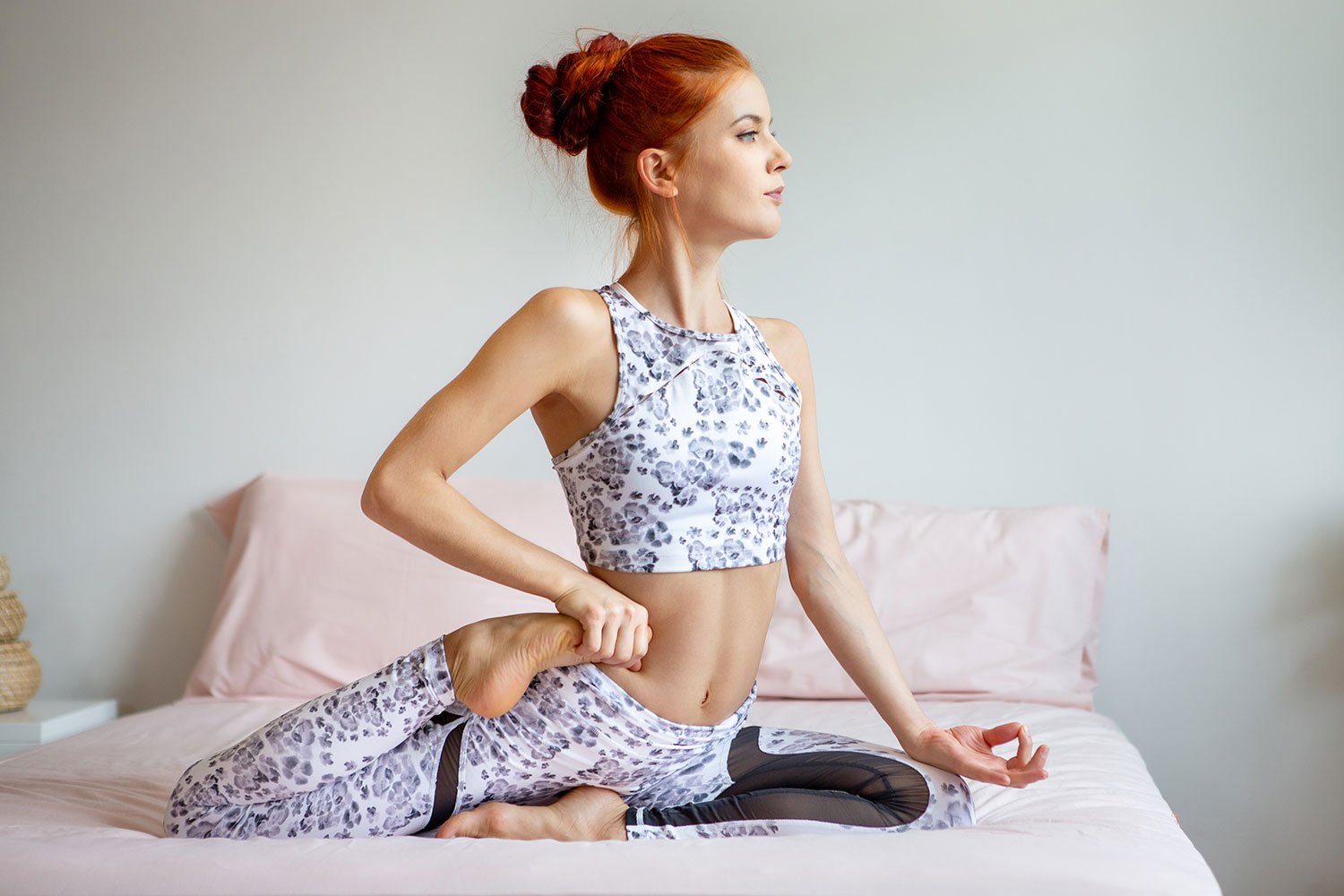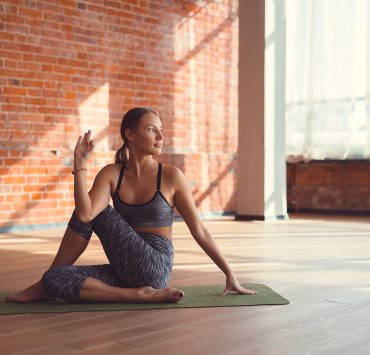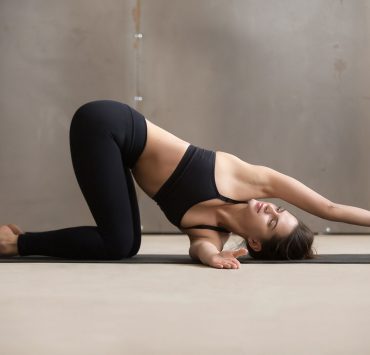
Rose graduated with a degree in Anthropology, which takes her…
There is no better way to wake up than with a morning yoga flow. Not only does yoga wake up our physical body, but it brings life into your emotional and spiritual realms, as well. However, not every yoga pose or practice style is ideally suited to wake you up in the morning. A vigorous vinyasa style may be too extreme or jarring to practice first thing upon waking. On the other hand, a slow and gentle yin yoga practice may make you want to crawl back under the covers and fall asleep again. Instead, the yogi should listen to their body and soul and design a morning practice around their unique needs.
Yoga does not remove us from the reality or responsibilities of everyday life but rather places our feet firmly and resolutely in the practical ground of experience. We don’t transcend our lives; we return to the life we left behind in the hopes of something better. Donna Farhi
These may change day to day, depending on how much sleep they got, what they ate the previous day, their emotional state, their plans for the rest of the day, and more.
Why You Should Practice Yoga in the Morning

There are many reasons to practice yoga in the morning, ranging from reasons based on scientific evidence, to more emotionally-focused reasons, or the teachings of tradition. Traditionally, yoga should be practiced on an empty stomach, making morning the ideal time for practice. Practicing on an empty stomach helps yoga boost the metabolism and begin peristalsis in the intestines. It also stretches out the muscles and prepares the body for the day ahead. Additionally, some studies point toward physiological benefits of exercising during a fasted state: better weight control, blood sugar regulation, and insulin sensitivity.
The future depends on what we do in the present. Mahatma Gandhi
Introducing a morning yoga practice can also help build a morning routine. Research found that the majority of people who engage in regular exercise do so in the morning. Perhaps this is because of the benefits they find from doing so – it energizes you for the day ahead, it reduces stress and anxiety, and starts the day on the right foot, so to speak. Practicing yoga in the morning can also improve your mental outlook for the remainder of the day. By beginning your day with a mindfulness focused practice, the effects carry over into daily interactions, whether these involve work stressors, food cravings, self-talk, and more.
8 Morning Yoga Stretches
Although a morning yoga practice should be flexible and dependent on the yogi’s physical and emotional state, there are also general guidelines for poses to practice in the morning. When choosing a morning yoga sequence, the yogi should focus on poses that offer a good balance between invigorating and calming. The poses should stretch and strengthen on a whole body level, bringing energy into the limbs and organs after a (hopefully) long night of sound sleep.
Salamba Balanasana — Child’s Pose

To perform child’s pose, start by kneeling on your mat, with the toes untucked. Sit back on your heels and extend the arms and torso out over your knees. Let your forehead gently meet and ground into the mat. Keep your arms outstretched, or alternatively let them rest back along either side of your thighs, with the palms facing up. Breathe here for a minimum of five breaths. Child’s pose is a wonderful restorative pose. Although it is calming, it is still reinvigorating. It provides a gradual stretch to the hips and low back. It can even be performed in bed, first thing upon waking. It is useful to practice to help you begin waking up the joints and make an intention for your morning practice.
Marjaryasana — Cat/Cow Pose

Cat-Cow pose is actually an alternation between two poses. It is performed by standing on your hands and knees. The hands should press strongly and evenly into the mat, right below your shoulders. The knees should also press into the mat, and be planted right below the hips. The toes are untucked. Begin the pose with a neutral spine. On an inhale, drop the belly, open the chest, and lift the head and gaze toward the ceiling. This is Cow pose. On an exhale, round the spine, dropping the head between the shoulders. Lift your belly button up toward the spine and reach the tailbone downward. This is Cat pose. Continue cycling between the two poses, alternating with each inhale and exhale. Do this for however feels good in your body, aiming for at least a minute. Cat-Cow pose not only wakes up the spine and increases flexibility and motion in the vertebrae, but it also gently promotes strengthening and stability in the wrists, shoulders, and knees. It is an ideal pose to practice in the morning as it helps increase the flow of prana, or life energy, which can become stagnant overnight.
Salamba Bhujangasana — Sphinx Pose

Start sphinx pose by lying flat on your belly. The toes are untucked and the tops of the feet press into the mat. Slowly, lift your chest and plant your forearms on the mat, palms pressing down into the mat. The elbows should be in line with and right below their respective shoulders. Inhale and open the chest here, lifting the gaze toward the ceiling. Remain in sphinx pose for a few breath cycles, feeling how the pose gently opens the chest and draws the shoulderblades together. Notice your breathing pattern, as your belly presses into the mat with each inhale. Sphinx pose is known as the infant of backbends, offering many of the backbend benefits whilst still being very accessible. It is perfect for an early morning yoga practice before the body has fully warmed up. Additionally, by pressing the belly against the mat with each breath, this can stoke the digestive system and get it moving.
Uttanasana — Standing Forward Fold Pose

To enter standing forward fold, or uttanasana as it is known in Sanskrit, start by standing tall on your mat. Inhale and reach the arms and gaze straight up, finding length through your spine and between each vertebra. Exhale, and fold forward. Try to think of hinging from the hips, maintaining a long, straight line in the spine, rather than rounding or hunching. Standing forward fold is all about hamstring flexibility, not back flexibility, so bend your knees if necessary. Let your neck and shoulders relax, maybe shaking your head slightly side to side. Let your arms hang down toward the mat. If they comfortably reach the mat, you may want to play with finding a clasp around the back of the ankles. Stay in standing forward fold for a few breath cycles, noticing how the pose changes with each breath, and as your body warms up. Standing forward fold introduces a gentle inversion to your body, and carries with it many of the inversion benefits such as redistributing lymphatic fluid and aiding circulation, without putting any undue strain on the body.
Adho Mukha Svanasana — Downward Facing Dog Pose

Downward facing dog pose is a staple yoga pose, used in most styles of yoga and central in the sun salutation sequences. In downward facing dog pose, the hands and feet press into the mat. They should be planted about a leg’s distance apart. The hips press back in this pose, letting the tailbone reach toward the back upper corner of the room. There should be an equal balance of weight between the upper and lower bodies. To avoid collecting tension in the shoulder girdle and neck, gently shake the head ‘yes’ and ‘no,’ and let it rest with the ears in line with the upper arms. The heels should reach toward the mat, although they may not meet it. Stay in downward facing dog for at least five breath cycles. You may want to ‘bicycle’ the legs by bending one knee and then the other. You can also lift one leg and then the other. Playing with this pose is a wonderful way to wake up the body in the morning, eradicating any joint stiffness. Downward facing dog is a powerful stretch, inversion, and strengthening exercise for multiple muscle grounds, such as the arms, shoulders, and thighs.
Utkatasana — Chair Pose

Practice chair pose by standing at the top of your mat. Your feet should be planted firmly into the mat, touching each other side by side. Knees are together. Bring your hands to heart center and press the palms together in Namaste. On an inhale, bend the knees slightly and dip the hips back and down into chair pose. The knees should not come too far forward – a good way to judge this is by always keeping your toes in view and not letting your knees go beyond them. From here, reach your arms straight up in the air. You can either maintain the mudra with your palms pressed together, or separate the palms but keep them parallel to each other. Try not to lift your shoulders and trapezius muscle here. Rather, let your shoulders relax down the back and away from your ears. Hold chair pose for a minimum of five breaths. The longer you hold it, the more heat you will feel building in your body. This is called tapas, or burning enthusiasm. If you tend to start your day sluggishly, or ‘wake up on the wrong side of the bed,’ then chair pose can help re-energize you and redirect your energy to start your day off right.
Anjaneyasana — Crescent Pose

Crescent lunge, or anjaneyasana, is a low lunge pose. The right foot is planted at the front of the mat, toes pointing forward, and knee tracking in line with ankle and hip. The ball of the left foot is planted at the back of the mat. Try to keep the hips squared toward the front of the mat by gradually bringing your left hip forward. Keep space between your low belly and front thigh. From here, inhale your arms straight up, with palms facing each other. This is crescent pose. Stay here for a minimum of five breaths, before repeating on the other side. You’ll notice and intense stretch in your back leg’s frontal hip. This is a useful stretch, particularly as a counter pose for those people who may spend the rest of their day sitting in a desk chair.
Prasarita Padottanasana — Wide-Legged Forward Bend Pose

Stand on your mat length-wise with your feet a little wider than hip’s width apart. The feet should be parallel to each other, and facing toward the side of the room. Plant your hands on your hips, and inhale and open the chest and gaze toward the ceiling. Exhale and fold forward over your legs, hinging from the hips. Think of your pelvis rotating around your femurs, and maintain a straight line in your spine as it extends down toward the mat. Keep your clasp at your hips and let your elbows point up toward the ceiling. The crown of your head should be hanging toward the mat. This pose offers and intense stretch through the backs of the legs and the hips. There are also various arm and clasp variations that can help intensify the pose or stretch the shoulders. As an inversion, it helps with circulation, reducing headaches and fatigue. It is both gentle and energizing, making it a perfect pose to practice in the morning.
Conclusion
Yoga can be beneficial no matter what time of day it is practiced – it is better to get on your mat daily than not at all. However, consensus within the modern yoga community, traditional yoga texts, and the general sports science field on exercise in general, is that a morning practice is most beneficial. These previous eight yoga poses can act as an entry into your morning practice. Have a sense of playfulness and practice these poses with variations that feel good in your body. Always try to tune into your unique mind and body state, and over time you will find more clarity on what yoga poses to include in your morning practice.
What's Your Reaction?
Rose graduated with a degree in Anthropology, which takes her understanding of basic human needs to a whole new level. Her intelligence and passion for healthy living is reflected in her written work.















Stretching is really useful. Especially when you age.